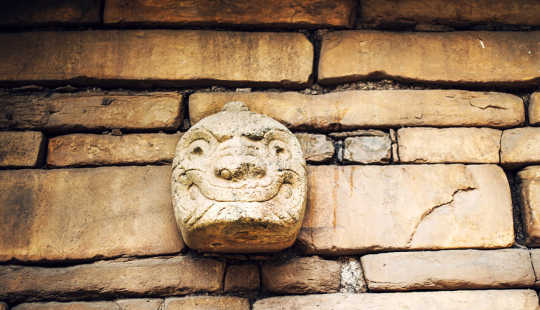 (Credit: Chavín de Huántar via Shutterstock)
(Credit: Chavín de Huántar via Shutterstock)
Authoritarianism is an issue of special gravitas this year, given claims of heavy-handedness in US presidential politics and widening conflicts against dictatorships in Syria and elsewhere. But why do we as a people let a single person or small group make decisions for everyone else?
A 3,000-year-old archaeological site in the Andes of Peru may hold the answer, says John Rick, associate professor of anthropology at Stanford University.
“They’re basically in a process of developing a hierarchy, a real social structure that has strong political power at the top.”
“More than 5,000 and certainly 10,000 years ago, nowhere in the world was anyone living under a concerted authority. Today we expect that. It is the essence of our organization. ‘Take me to your leader. Who’s in charge here?’ So where did that come from?”
Currently a fellow at the Stanford Humanities Center, Rick is gathering the large amount of evidence from more than two decades of fieldwork at the ancient site of Chavín de Huántar, where that culture developed from roughly 900 BCE to 200 BCE.
He will present his research on Chavín and how authority-minded systems arose in human society in an upcoming book, Innovation, Religion and the Development of the Andean Formative Period, that will explore the role of religion in the shaping hierarchical societies in the New World, especially the Andes.
{youtube}OxankFhtvJA{/youtube}
Priests in power
Chavín was a religious center run by an elaborate priesthood. Located north of Lima, in the Andes Mountains, it sat at the mouth of two large rivers that once held religious significance for the region. During its existence, the Chavín priesthood subjected visitors to an incredible range of routines, some of which involved manipulating light, water, and sound.
The priesthood deliberately worked with underground spaces, architectural stonework, a system of water canals, psychoactive drugs, and animal iconography to augment its demonstrations of authority.
“I was fascinated with the evidence we have for this idea of manipulation of people who went through ritual experiences in these structures,” he says.
The priesthood sought to increase its level of authority, Rick says. “They needed to create a new world, one in which the settings, objects, actions, and senses all argue for the presence of intrinsic authority—both from the religious leaders and from a realm of greater powers they portray themselves as related to.”
Prior archaeological research on Chavín has suggested that the site attracted people because it was a cult of devotion. However, Rick and colleagues believe something else was going on.
They found very little evidence that common people were involved in worshipping at Chavín. Instead they have surmised that visitors were elite pilgrims, local leaders from far-flung parts of the Central Andes. These people were looking for justification to elevate their own status and their positions of control in society.
After their experiences at Chavín, they would use the experiences to more adroitly disseminate messages of authority to their own people, Rick says. “They’re basically in a process of developing a hierarchy, a real social structure that has strong political power at the top,” Rick says.
Drugs and stone
Architecture was critical to producing this effect. The researchers estimate that there are 2 kilometers of underground labyrinthine, gallery-like spaces, which were clearly designed to confine and manipulate those who entered them.
This was a removal from one world and the creation of another. As a result, the rituals were dramatic and effective in changing ideas about the nature of human authoritative relationships.
Stone was another key element. Leaders at Chavín often recorded their actions by engraving their deeds in stone. While other ancient sites used wood, papier-mâché or textiles, those at Chavín revealed their strategies in the ground and rock itself.
The priesthood also manipulated visitors with psychoactive drugs. Evidence is found in the portrayal of psychoactive plants in stone engravings, with clear illustrations of paraphernalia and the drugs’ effects on humans.
Rick believes Chavín was a place where human psychology was explored and experiments were being conducted to test how people would react to certain stimuli.
Yet another tool of authoritarian manipulation was water, through a sophisticated hydraulic system and underwater canals at the site. Despite water’s danger in flooding, the Chavín priesthood clearly attempted to control water visibly.
“They were playing with this stuff,” Rick says. “They were using water pressure 3,000 years ago to elevate water, to bring it up where it shouldn’t be. They’re using it as an agent to wash away offerings,” he says.
The water control, is a powerful demonstration of human agency over nature, Rick says. He conjures up a picture of what it must have been like for pilgrims to visit Chavín and its dark, underground spaces, undergo strange experiences, and observe the seeming abilities of priests to wield supernatural powers.
Ancient places like Chavín reflect a major change in the way human beings would treat each other, Rick says. Such places gave rise to “complex, highly authoritarian, communications-driven, sometimes charismatically led societies” in human civilization.
Source: Tanu Wakefield for Stanford University
Related Books
at InnerSelf Market and Amazon




























